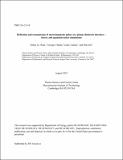| dc.contributor.author | Ram, Abhay K. | en_US |
| dc.contributor.author | Vahala, George | en_US |
| dc.contributor.author | Vahala, Linda | en_US |
| dc.contributor.author | Soe, Min | en_US |
| dc.date.accessioned | 2025-03-21T20:20:12Z | |
| dc.date.available | 2025-03-21T20:20:12Z | |
| dc.date.issued | 2021-08 | |
| dc.identifier | 21ja018 | |
| dc.identifier.uri | https://hdl.handle.net/1721.1/158688 | |
| dc.description | Submitted for publication in AIP Advances | |
| dc.description.abstract | There is considerable interest in the application of quantum information science to advance computations in plasma physics. A particular point of curiosity is whether it is possible to take advantage of quantum computers to speed up numerical simulations relative to conventional computers. Many of the topics in fusion plasma physics are classical in nature. In order to implement them on quantum computers it will require couching a classical problem in the language of quantum mechanics. Electromagnetic waves are routinely used in fusion experiments to heat a plasma or to generate currents in the plasma. The propagation of electromagnetic waves is described by Maxwell equations with an appropriate description of the plasma as a dielectric medium. Before advancing to the tensor dielectric of a magnetized plasma, this paper considers electromagnetic wave propagation in a one-dimensional inhomogeneous scalar dielectric. The classic theory of scattering of plane electromagnetic waves at a planar interface, separating two different dielectric media, leads to Fresnel equations for reflection and transmission coefficients. In contrast to plane waves, this paper is on the reflection and transmission of a spatially confined electromagnetic pulse. Following an analytical formulation for the scattering of a Gaussian pulse, it is deduced that the maximum transmission coefficient for a pulse is $\sqrt{n_2/n_1}$ times that for a plane wave; the incident and transmitted pulses propagating in dielectric media with refractive indices $n_1$ and $n_2$, respectively. The analytical theory is complemented by numerical simulations using a quantum lattice algorithm for Maxwell equations. The algorithm, based on the Riemann-Silberstein-Weber representation of the electromagnetic fields and expressed in term of qubits, is an interleaved sequence of entangling operators at each lattice site and unitary streaming operators which transmit information from one site to an adjacent lattice site. Besides substantiating results from the theory for Gaussian pulses, numerical simulations show their validity for non-Gaussian pulses. Apart from their time-asymptotic forms, the simulations display an interplay between the incident, reflected, and transmitted pulses in the vicinity of the transition region between two dielectric media. | |
| dc.publisher | AIP | en_US |
| dc.relation.isversionof | doi.org/10.1063/5.0067204 | |
| dc.source | Plasma Science and Fusion Center | en_US |
| dc.title | Reflection and transmission of electromagnetic pulses at a planar dielectric interface -- theory and quantum lattice simulations | en_US |
| dc.type | Article | en_US |
| dc.contributor.department | Massachusetts Institute of Technology. Plasma Science and Fusion Center | |
| dc.relation.journal | AIP Advances | |
